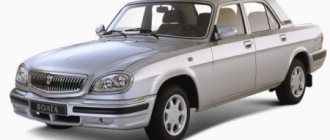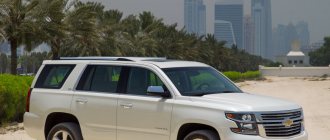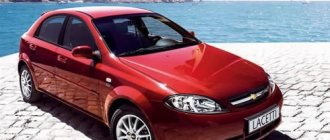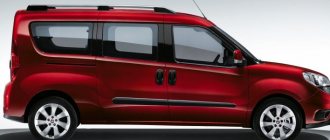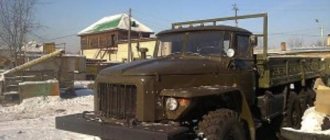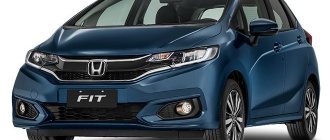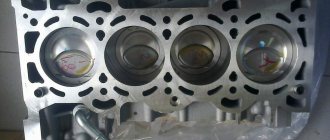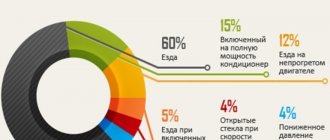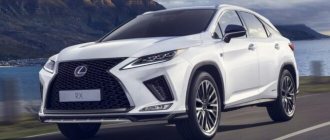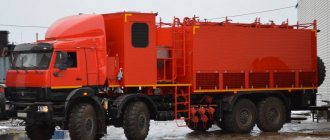Kia Spectra fuel tank sizes
The width of Kia Spectra fuel tanks for all modifications ranges from 50 (l) to 53 (l).
Fuel tank parameters for standard modifications:
1.8 l., Petrol, Automatic, 4 speed, Front:
1.8 l., Petrol, Mechanical, 5 speed, Front:
1.6 l., Petrol, Automatic, 4 speed, Front:
Tank characteristics:
The main characteristics of the fuel tank include the following indicators:
- Length (L): overall length at the most protruding parts;
- Width (B): overall width at the most protruding parts;
- Height (H): overall height at the most protruding parts;
- Volume.
Important: detailed parameters of automobile fuel tanks by modification are presented in the table below.
Other names:
years of production of all modifications of the model: 2001-2009.
Specifications
| Type | Volume | Power | Torque | Overclocking | Maximum speed | Number of cylinders |
| Petrol | 1.6 l | 101 hp | 145 H*m | 12.6 sec. | 180 km/h | 4 |
More details
The model was equipped with any of 3 types of gasoline 4-cylinder naturally aspirated engines.
- The first engine had a volume of 1.6 liters and with its volume it produced 101 horsepower. The engine will need 11 and a half seconds to accelerate the car to the first hundred. The unit consumes 10 liters in the city and 6 on the highway. There are complaints about the engine, it does not work stably, that is, in the first gear it pulls well, in the second not so much, but in the rest it is already better.
- The next engine has a volume of 1.8 liters and produces 126 horsepower. Unfortunately, nothing is known about the dynamic performance of this unit, since it was not supplied to our country. The known maximum speed is 196 km/h and the combined cycle consumption is 10 liters.
- The last engine is a 2-liter unit with a capacity of 140 horsepower. For some reason, it accelerates the car more slowly than the weakest one. The KIA Spectra engine takes 12.2 seconds for the sedan to reach the first hundred, and the top speed is only 175 km/h. Combined cycle consumption is a little more than 9 liters.
All engines are offered paired with either a 5-speed manual or a 4-speed automatic. Regardless of the engine and gearbox, the car will always have front-wheel drive. The gearbox travel is very long, and the clutch pedal is pressed lightly. It’s difficult to say whether this is a plus or a minus, decide for yourself. The settings of the units are incomprehensible, it performs well at high speeds, but gives a very sharp pick-up at 4000 thousand, and this thrust could have been distributed over the entire range.
The suspension of the model works separately; during active driving, the driver will have the feeling that the rear part cannot keep up with the muzzle. I am glad that during sharp turns there is no strong roll, and during a quiet ride the car drives smoothly. Also, on rough roads, the chassis makes very terrible and frightening sounds. The brakes are completely disc and there have been no complaints from the owners.
Other parameters of Kia Spectra:
| General parameters of Kia Spectra fuel tanks | |||
| Drawing General General view of fuel tanks | Width min (mm) Minimum fuel tank width for different Kia Spectra modifications. | ||
The measurement is taken on the outside.
| Width max (mm) Maximum width of the fuel tank for different modifications of the Kia Spectra. The measurement is taken on the outside. | Modifications Number of modifications of the model in our database | ||
| (drawing) | 50 (l) | 53 (l) | 8 |
| Kia Spectra fuel tank parameters | |
| Year Year of manufacture of the model or modification of the car | |
Caution: the above data are the official figures of the manufacturer, however, please note that the information is for reference only and does not guarantee absolute accuracy.
Operation Kia Spectra 2008
Kia Spectra is an inexpensive foreign car. Like other budget cars, it has a few problems. But some owners do not notice them even during long-term use.
It is convenient to drive a car with maximum configuration. It is equipped with a good climate system, driver assistance devices and other elements. But even in the basic configuration, this model is convenient, practical and of high quality, despite the Russian assembly.
Advantages and disadvantages
According to reviews from car enthusiasts, the Kia Spectra has five “pluses”:
- reliability;
- spacious interior;
- inexpensive service;
- spacious trunk;
- reliable suspension, specially designed for imperfect Russian roads.
Among the disadvantages, drivers note, first of all, the low cross-country ability of the car, which is designed for driving around the city and cannot drive onto the curb, drive over holes and bumps. Another drawback is poor sound insulation. When driving on studded tires, the driver will hear them scratching the asphalt. Some people have noticed high fuel consumption and poor quality gearbox. But these are uncharacteristic problems of this model.
Maintenance and repair costs
Drivers have different requirements for a vehicle, but it is important for each person that maintaining the vehicle’s performance is inexpensive. During operation, wipers and low and high beam lamps often fail. These parts are available in all auto parts stores, and they can be replaced independently, without the help of a technician.
Technical characteristics of Kia Spectra 2
In Russia, serial assembly of the Kia Spectra (known as the Kia Sephia 2 on the South Korean market) began at the end of 2004 at the Izhevsk Automobile Plant. KIA Spectra cars are assembled from vehicle kits in four trim levels: NA, NV, NS and HD.
The front suspension is MacPherson type with lower wishbones, the rear is independent. The front and rear suspensions of the car are equipped with anti-roll bars.
Cars in all trim levels are equipped with injection engines (with a distributed fuel injection system) with a working volume of 1.6 liters and a power of 77.4 kW (101.1 hp).
The sedan-type body is monocoque, all-metal, of welded construction with hinged front fenders, doors, hood and trunk lid.
The transmission is made according to a front-wheel drive design, with front wheel drives equipped with constant velocity joints. Cars are equipped with mechanical (NA and NV configurations) or automatic (HC and HD configurations) gearboxes.
The front wheel brakes are disc brakes with a floating caliper. The rear wheel brakes are drum-type, with automatic adjustment of the gaps between the brake pads and drums. Depending on the configuration, vehicles may be equipped with an anti-lock braking system (ABS).
The steering is safety-resistant, with a rack-and-pinion steering mechanism, equipped with a hydraulic booster and a tilt-adjustable steering column.
There is an airbag installed in the steering wheel hub.
The HA equipment includes power steering, tilt-adjustable steering column, ventilated disc mechanisms of the front wheels, seat belts with pretensioner (for the driver and front passenger) and inertial seat belts for the outer (rear seat) passengers, an additional brake light , windshield washer and cleaner, driver and front passenger airbags, electric headlight adjustment, digital clock, immobilizer, external telescopic antenna, audio preparation (four speakers and a radio), remote opening of the fuel tank flap and trunk lid from the passenger compartment, cigarette lighter and ashtray equipped with lighting, central locking, electric sliding windows for interior doors. The NV package additionally includes air conditioning, decorative wheel caps, electric drive and heated side mirrors, and front fog lights. The NS package, in addition to what is listed for the NA package, includes air conditioning, and the HD package includes an electric telescopic antenna, anti-lock brake system (ABS), and electric heated front seats.
In this publication, most repair operations are shown using the example of a car in the most complete configuration of the NV with a manual transmission.
The technical characteristics of the car are given in table. 1.1.
The overall dimensions of the car are shown in Fig. 1.1.
The car elements located in the engine compartment and the main units are shown in Fig. 1.2-1.4.
| Volume (l) Tank volume in (l) | ||||
| 1.8 l., Petrol, Automatic, 4 speed, Front | ||||
| Fuel tank volume | 50 (l) | |||
| 1.8 l., Petrol, Mechanical, 5 speed, Front | ||||
| Fuel tank volume | 50 (l) | |||
| 1.6 l., Petrol, Automatic, 4 speed, Front | ||||
| Fuel tank volume | 50 (l) | |||
| 1.6 l., Petrol, Mechanical, 5 speed, Front | ||||
| Fuel tank volume | 50 (l) | |||
| 1.5 l., Petrol, Automatic, 4 speed, Front | ||||
| Fuel tank volume | 50 (l) | |||
| 1.5 l., Petrol, Mechanical, 5 speed, Front | ||||
| Fuel tank volume | 50 (l) | |||
| 2 l., Petrol, Automatic, 4 speed, Front | ||||
| Fuel tank volume | 53 (l) | |||
| 2 l., Gasoline, Mechanics, 5 speed., Front | ||||
| Fuel tank volume | 53 (l) | |||
| Total information | ||||
| Number of seats including driver's seat | 5 | |||
| Curb weight of the vehicle with manual/automatic transmission, kg | 1170/1201 | |||
| Gross vehicle weight with manual/automatic transmission, kg | 1600/1630 | |||
| Overall dimensions, mm | 4610x1720x1415 | |||
| Minimum turning radius, m | 4,9 | |||
| ground clearance, mm | 156 | |||
| Maximum vehicle speed, km/h | 186 | |||
| Acceleration time from standstill to 100 km/h with gear shifting, s | 11,6 | |||
| Fuel consumption, l/100 km: | ||||
| urban cycle | 10,5 | |||
| at a speed of 90 km/h | 6,0 | |||
| at a speed of 120 km/h | 7,9 | |||
| Type | Four-stroke, gasoline, with two camshafts | |||
| Number, arrangement of cylinders | Four, vertically in a row | |||
| Number of valves | 16 | |||
| Cylinder operating order | 1-3-4-2 | |||
| Cylinder diameter, mm | 78 | |||
| Piston stroke, mm | 83,4 | |||
| Working volume, cm3 | 1594 | |||
| Maximum power, kW (hp) | 74,4(101,1) | |||
| Torque, Nm | 148 | |||
| Compression ratio | 9,5 | |||
| Minimum crankshaft rotation speed at idle, min1 | 800+-100 | |||
| Transmission | ||||
| Clutch | Single-disc, dry, with diaphragm pressure spring and torsional vibration damper, permanently closed type | |||
| Clutch release drive | Hydraulic, backlash-free (for vehicles with manual transmission) | |||
| Transmission | Depending on the vehicle configuration, five-speed manual, two-shaft, with synchronizers in all forward gears or four-speed automatic | |||
| Gear ratios of manual/automatic transmission: | ||||
| 1st gear | 3,417/2,800 | |||
| 2nd gear | 1,895/1,540 | |||
| III gear | 1,293/ 1,000 | |||
| IV gear | 0,968/ 0,700 | |||
| V gear | 0,780/ – | |||
| reverse gear | 3,272/ 2,333 | |||
| Wheel drive | Front, shafts with constant velocity joints | |||
| Front suspension | Independent, MacPherson strut, with hydraulic shock absorbers, coil springs and anti-roll bar | |||
| Rear suspension | Independent, with hydraulic shock absorbers, coil springs, longitudinal and two wishbones, with anti-roll bar | |||
| Wheels | Steel, disc, stamped | |||
| Rim size | 5.5JJx14 | |||
| Tires | Radial, tubeless | |||
| Tire size | 185/65 R14 | |||
| Steering | ||||
| Type | Trauma-proof, with hydraulic booster | |||
| Steering gear | Rack and pinion | |||
| Service brakes: | ||||
| front | Disc, with single-cylinder floating caliper | |||
| rear | Drums | |||
| Service brake drive | Hydraulic, dual-circuit, separate, diagonal, with vacuum booster and anti-lock brake system (ABS) | |||
| Parking brake | With mechanical drive to the rear wheels from a floor lever, with a power-on alarm | |||
| Wiring diagram | Single-wire, negative pole connected to ground | |||
| Rated voltage, V | 12 | |||
| Accumulator battery | Starter, serviced, capacity 55 Ah | |||
| Generator | AC current, with built-in rectifier and electronic voltage regulator | |||
| Rated output current, A, at a voltage of 13.5 V | 80 | |||
| Starter | With permanent magnet excitation, remote control with electromagnetic activation and freewheel, power 0.85 kW | |||
| Type | Sedan, all-metal, monocoque, four-door | |||
| Rice. 1.2. The engine compartment of the car (top view) (the decorative cover has been removed for clarity): |
| 1 – mounting block of fuses and relays; 2 – windshield wiper gear motor; 3 – air filter; 4 – battery; 5 – ignition coil; 6 – radiator of the engine cooling system; 7 – thermal protective screen; 8 – power steering pump; 9 – windshield washer reservoir; 10 – desiccant; 11 – power steering reservoir; 12 – right suspension support of the power unit; 13 – solenoid valve for purge of the adsorber; 14 – receiver; 15 – engine; 16 – air supply pipe; 17 – reservoir for hydraulic brakes and clutch release |
| Rice. 1.3. The engine compartment of the car (bottom view) and the main units |
| 1 – air conditioning compressor; 2 – engine crankcase; 3 – intermediate pipe of the exhaust gas system; 4 – protective beam of the power unit; 5 – gearbox; 6 – brake mechanism of the left wheel; 7 – left front suspension arm; 8 – drive of the left front wheel; 9 – plug for draining oil from the gearbox; 10 – exhaust gas neutralizer; 11 – plug for draining oil from the engine; 12 – right front suspension arm; 13 – drive of the right front wheel; 14 – brake mechanism of the right wheel |
| Rice. 1.4. Main components of the car (bottom rear view): |
| 1 – rear suspension cross member; 2 – niche for a spare wheel; 3 – main muffler; 4, 7 – right transverse arms of the rear suspension; 5 – right fist of the rear suspension; 6 – right trailing arm; 8 – additional muffler; 9 – thermal protective screen; 10 – stabilizer bar for rear suspension; 11 – fuel tank; 12 – parking brake system drive cable; 13 – left shock absorber strut of the rear suspension |
The information is relevant for Kia Spectra models 2004, 2005, 2006, 2007, 2008, 2009, 2010, 2011.
Salon. Modest but spacious
The car's interior does not please with its design delights and expensive finishing materials. By and large, everything is quite modest - gray plastic and gray velor of a darker shade, no leather or wood inserts “sorry”, but also no plastic to look like leather and wood “thank you for that”. The level of assembly and fit of the interior does not cause any complaints - everything is checked, the gaps are the same everywhere and are not noticeable. The soft dashboard resembles the front panel of the Elantra, and the instruments have two scales - in kilometers and miles. There are no complaints about the ergonomics of the driver's seat. I'm also glad that the steering column is adjustable.
But the rear sofa deserves the most positive reviews. Still, the rather long length and very serious width of the car served the rear passengers well - there is enough space in the legs, shoulders, and above the head. At the same time, the Spectra also boasts a fairly large luggage compartment with a volume of 450 liters.
How many special fluids and what oils are suitable for Kia Spectra
Kia Spectra is a decent Korean-made car. With proper care, owners usually do not have any problems. The model was produced from 2000 to 2011. Available in two body types - sedan and hatchback. It is equipped with gasoline and diesel power plants of different power - 88 - 140 hp. Transmission – front-wheel drive, manual or automatic transmission.
Filling volumes and brands of oils and liquids Kia Spectra
Filling/lubrication point
Name of oil/liquid
How much and what to fill in Kiya Spectra
Fuel tank volume – 50 l. The manufacturer recommends filling gasoline engines with AI-95 or AI-92 fuel, and diesel engines with high-quality diesel fuel.
Replacement schedule is 15 thousand km. If the annual mileage is less, then once a year. Refill volume 3.5 l.
The operating instructions indicate SAE 10W30 oil with ILSAC GF3 or API SG approval. The manufacturer filled in the Korean lubricant SK ZIC A+ 10W30. You can use analogues that cost less.
According to maintenance, antifreeze should be changed every 60 thousand kilometers or every 4 years. Suitable carboxylate class coolant, type G12 with shades of red. Refill volume – 6.0 l.
It is important to change transmission oil in a timely manner - every 60 - 70 thousand km. For manual transmissions, MTF 75W-90 lubricant is suitable, for automatic transmissions - ATF SP-III. The filling volume is 2.8 and 5.4 liters, respectively.
The manufacturer recommends the first replacement of brake fluid after three years of operation, subsequent ones after two. DOT 3 or DOT 4 will do.
